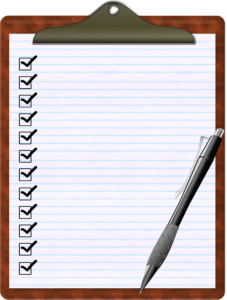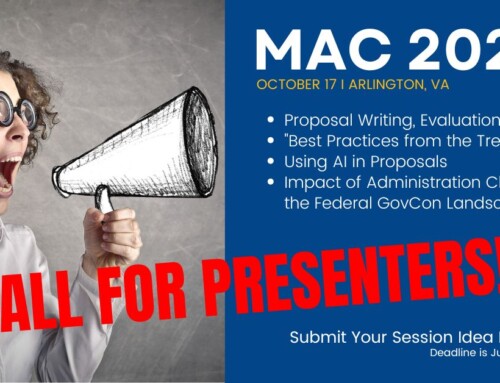
Originally published on APMP’s blog, Winning the Business https://winningthebusiness.com/proposal-coordinator-commandments/
Proposal coordinators are often overlooked, but the value they can bring to a team is instrumental in enabling the proposal manager to manage the bid process most efficiently from start to finish. Sure, a coordinator’s role is to assist the proposal manager, but what does that really mean? What differentiates a good coordinator from a great one?
There are five “commandments” that every coordinator should follow to provide the high-quality support that becomes crucial in making the bid process run productively.
1. Tailor your support to the type of proposal manager you are assisting.
Typically, proposal managers are particular about the way they manage proposals. Some like to be hands-on in every deliverable, while others prefer to divide and conquer. Coordinators must adapt to the management style of their proposal manager to provide the support that best compliments them.
By doing so, you will build trust and a stronger working relationship with the proposal manager. Inherent in trust comes strong communication, which solidifies a team foundation that can repeatedly deliver quality proposals within any timeline.
Adapting to differing management styles requires observation and open dialogue. Make note of the behaviors and organizational style of the proposal manager to piece together where your support would be most beneficial. Ask them about their preferred style of communication, their individualized proposal development process and where they most need your support.
2. Always close the communication loop.
A communication loop exists where communication is open-ended with no confirmation of receipt or knowledge of what is being done. There is a fool-proof process that can be followed to close that loop. If any of these steps are missing, there will be a communication breakdown that will cause delays in the proposal process.
- Step 1: Confirm communication. When receiving a communication that is essential to proposal development, send a follow-up email confirming the message was received.
- Step 2: Complete the action or forward to the right individual. If the communication requires further action that can completed by you, process the request as soon as you are able. If the communication’s next steps cannot be completed by you, forward the message to the right individual who can process the action item or request. Make sure to include context on what the communication is about and provide a deadline for when the action item or request needs to be complete by.
- Step 3: Relay status back to associated parties. By informing the original party of the communication status, you avoid causing them additional work by preventing them from following up on an action that is already in progress and allowing them to focus on other tasks.
- Step 4: Track the action item or request to completion. Ensure that the action item is completed by the requested due date.
- Step 5: Relay completion status back to associated parties. Informing the original party of the completion status will quickly propel proposal development activities by allowing task dependencies to begin immediately.
3. Become the tool guru.
We use tools every day throughout the proposal process, whether they are Commercial Off the Shelf (COTS) products or internally developed, to aid in the collaboration between proposal teams and subject-matter experts. Tools are a great asset, but their utilization is only as effective as the user is knowledgeable. Become the go-to person with the answers on how to use the tools, and you will effectively oil the machine that keeps the proposal on track.
4. Be proactive and anticipate needs.
Switch from a reactive mindset to a proactive one by seeing a need and filling in the gap to solve the issue at hand. This can be as simple as anticipating SME availability prior to the proposal manager assigning color team reviewers to as large as spearheading initiatives to improve the content reuse library. This will provide immeasurable value as best practices are translated into easily digestible process improvements that can be quickly implemented.
- Proposal-focused: The best way to anticipate needs is to think of tasks as either working in parallel or dependent upon each other. Is there another task that can be worked in parallel, or does it have a prerequisite task that needs to be completed first? If there is a dependency, has the task been started on or is it in progress? These are the types of questions to constantly ask yourself throughout the proposal development process.
- Initiative-focused: A simple way to start is to examine your team’s task routines. Is there a lot of double work that can be simplified somehow? Is there an avenue for an automated workflow that can free up resources to focus on priority tasks?
Second, analyze the effort required to develop the solutions to those questions. Will the solution have an immediate benefit, and if so, what would be required to produce the results needed? Finding solutions to these questions leads to various initiatives that lead to a continuous improvement mentality that will propel your proposal team to work more efficiently.
5. Organize with purposefulness.
Not only do coordinators need to be expert task executors for individual proposal efforts, they also need to effectively juggle multiple proposals at the same time. These guidelines will revitalize your to-do list:
- Daily dedication and maintenance: Similar to how each day in a bid calendar is important to hit every milestone, your to-do list should mirror that same design. However you organize your to-do list, the habit of daily dedication reinforces a higher caliber of task execution as you move multiple deadlines and projects closer to the finish line. Of course, it isn’t enough to create a to-do list, you must also keep it up to date. Regularly maintaining your to-do list will ensure that all priorities are given the proper amount of attention.
- Analysis: The right organization system is the one that is tailored to your working style. Knowing what type of medium works best and whether color-coding tasks is beneficial or takes more time than is worth requires analysis of yourself and your habits. Do you need to quickly jot down tasks and cross them out, or do you need to organize your tasks into time blocks? Ask yourself these types of questions to determine what works best for you.
- Continuous improvement: The analysis of yourself and your habits isn’t a one-time activity. What once worked for you may not be the same solution to how you organize increasing responsibility or additional projects and initiatives. Keep a continuous improvement mindset by making it a habit to self-reflect, then take that analysis and apply it to your organizational style.




Leave A Comment